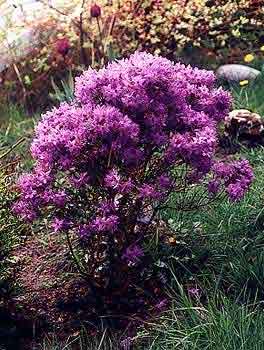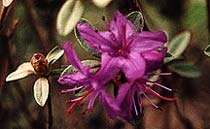 A Chinese Friend:
A Chinese Friend:
Rhododendron yungningense
"For the sun that shone at the dawn of spring,
For the flowers which bloom & the birds that sing,
For the verdant robe of the gray old earth,
For her coffers filled with their countless worth."
-Edward Smyth Jones,
early 20th Century black poet,
b. 1881
early 20th Century black poet,
b. 1881
The small leafed Rhododendron yungningense was formerly named R. glomerulatum. The old name was still used on the label when we bought ours. It's named for Yungning in southwest Sichuan in China where it grows wild; the older name meant "small clusters" alluding to the flowers.
This is a true species rather than a cultivar, which I guess is why it has no common name attached. So we named ours Jane Wu. "Hello Jane Wu, looking a little blue around the calyx today aren't we."
Natural species rhodies have been too often displaced from the average garden by the vast array of cultivars we are offered, but thanks to the Rhododendron Species Foundation, which has a splendiferous garden a very short drive from where we live, awareness of the charms of the natural species shrubs is heightening in the Northwest.
 It was brought to western gardens by Scottish plant explorer George Forrest (1873-1932), who died in China on his fifth expedition. He spotted this particular rhody on a flower hunt in 1921, & it has since proven useful in developing hardy evergreen hybrids with blue or violet flowers. This broadleaf evergreen can reach four feet of height, though ours is a hair under three feet. I won't be looking for it to get bigger very soon as it's a slow grower. We planted it near a rounded Boxleaf Hebe & a fruiting cherry tree, where it gets a goodly amount of afternoon sun, for it likes less shade than many rhodies.
It was brought to western gardens by Scottish plant explorer George Forrest (1873-1932), who died in China on his fifth expedition. He spotted this particular rhody on a flower hunt in 1921, & it has since proven useful in developing hardy evergreen hybrids with blue or violet flowers. This broadleaf evergreen can reach four feet of height, though ours is a hair under three feet. I won't be looking for it to get bigger very soon as it's a slow grower. We planted it near a rounded Boxleaf Hebe & a fruiting cherry tree, where it gets a goodly amount of afternoon sun, for it likes less shade than many rhodies.  Ours was in full bud early in March, showing peeps of purple toward month's end, but doesn't really get the job done until a week into April. The flowers are most striking for about two weeks, then spend a week falling from the shrub.
Ours was in full bud early in March, showing peeps of purple toward month's end, but doesn't really get the job done until a week into April. The flowers are most striking for about two weeks, then spend a week falling from the shrub. Oddly enough it continues to produce a few random flowers deep into April; day after day, when it's blooming period was weeks over, I'd go into the garden & spot one or two new blossoms on it. The flowers are five-petal funnels in bright lavender-blue & far more delicate in appearance than is the case with fancy cultivars. It has an upright growth like a tiny tree.
Because it likes more sun than most rhodies it is commonly placed in rockeries. Growing in its native China at very high elevations on rocky slopes, it is not fussy as to conditions, & is extremely cold-hardy.
For more flower portraits of this shrub, see the
R. yungingense page of the Azaleas & Rhodies Blossoms Gallery
R. yungingense page of the Azaleas & Rhodies Blossoms Gallery